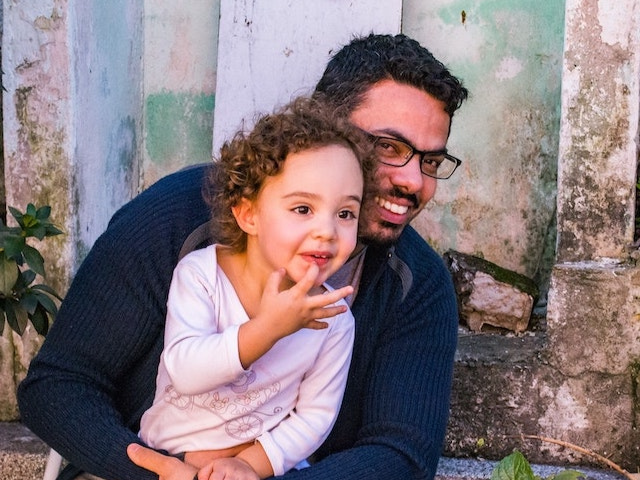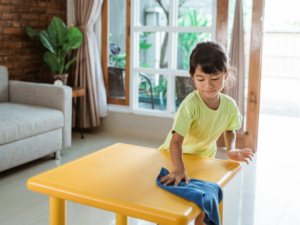What is Positive Parenting?
“Positive parenting” is a term we hear often, but it is not always clearly defined. Many believe that to be a positive parent, you must be an easy-going and permissive parent, but that is not the case. Positive parenting is a parenting style that emphasizes caring, communication, teaching, leading, and providing.
Caring
Care can take many forms, including verbal affirmations, physical affection, asking about & paying attention to our children’s feelings and needs, showing compassion and warmth, and spending quality time together.
- “I love spending time with you.” Offering a hug “just because.”
- “I see that you’re upset because you spilled your favorite drink. Accidents happen, it’s okay. Do you want a new drink or a hug?”
- Spend 10 minutes of quality time with your child, let them take the lead, and describe their play.
Communication
Demonstrate healthy ways of expressing thoughts and feelings and listening actively and empathically to others.
- “I can see that you’re feeling upset because you want to play with the toy that Bobby is using. It’s okay to feel that way. Let’s think of a way to solve this problem together.”
Teaching
Teach emotional identification, how to appropriately socialize with others, and how to cope with big emotions.
- “Mommy had a rough phone call. Someone was mean to me, and I am feeling frustrated and sad. I will take some deep breaths to help calm my body down.”
Leading
Guide and support children as they learn without controlling or manipulating their behavior.Set clear boundaries & establish structure. Shepherd children as they navigate this big world & learn new skills.
- “I know you want to go outside and play, but it is raining right now. We can’t go outside when it is raining because it is not safe. How about we find something fun to do inside instead?”
Providing
Ensure children’s basic needs are met, including food, shelter, physical activity, and medical care.
- Provide a nutritious diet that helps their bodies and minds grow to their full potential, including plenty of fruits and vegetables.
Why Use Positive Parenting?
Research has shown a link between problematic behaviors in children and parents who provide the highest level of positive parenting.
Positive Parenting
Leads to better school adjustment and school readiness.
Promotes secure attachment with a caregiver, which helps children cope better with challenges (e.g., parental stress, family instability, poverty).
Negative Parenting
Associated with behavioral issues (e.g., aggression, delinquency)that increase as the child develops.
Often involves ineffective discipline strategies (e.g., scolding, lack of monitoring, spanking), which may result in a child developing antisocial behaviors.
Positive Parenting Practices
To practice positive parenting, you must be able to put yourself in your child’s shoes. Sometimes it can be rather challenging to understand your child’s point of view, but it is important to remember that they are learning and modeling what they see from their environment. Make sure to look out for your child’s cues and see what they might need in the moment (e.g., a break from what they are doing, being taken away from excessive stimuli, or being given a snack to change the situation).
Praise your child
Praise can highlight your child’s behavior and strengths. This is when you point out a specific behavior and do so immediately following that desirable behavior. For example, if you see your child get dressed all on their own without your assistance, you might say, “I like the way you dressed yourself today!”. It is important not to be stingy with praise or think your child “ought” to demonstrate a specific behavior without being rewarded. Avoid being too general with your praise–instead of saying “Good job,” try “Good job tidying up your placemat after dinner!” Also, note that praise can be verbal or non-verbal -it can include comments, hugs, high-fives, and smiles.
Connect with your little one
Remember to take time to connect with your child. Life can present as challenging at times. It is important to take a moment to find that connection with your little one. For example, engage in eye contact with your child and provide a warm and nurturing smile. You can also take a moment to hug and cuddle your child while doing an activity together.
Daily Quality time
Setting aside time for you and your child is crucial and enables them to form a stronger attachment. This can be done by setting aside 15 minutes daily with just you and your child. Allow your child to pick an activity of their choice and have them lead the activity. Really focus on letting them lead the activity and narrate out loud what they are doing while also praising your child throughout (e.g., “I like how you decided to add polka dots to the dress you are drawing!”). Some fun examples include drawing together, playing pretend, and allowing your child to invent a game.
Nurture and Structure
Providing an environment that offers your child both nurturance and structure is important. Children are bound to make mistakes and misbehave. By setting clear boundaries and appropriate age-based guidelines, you are ensuring your child understands there are limits to their behavior and consequences. Engage in eye contact with your child and, in an even-toned voice, and explain the rules and consequences.
Active Ignoring
Active ignoring is when you remove all attention from your child when they are misbehaving. It is most useful when your child is throwing a tantrum. It is important not to accidentally reward problematic behavior by giving attention to the behavior (e.g., yelling back or resorting to physical punishment). When the negative behavior does stop, give a lot of attention to your child.
Together, all these factors will help us grow and maintain a close and healthy relationship with your child. This will also guarantee that you and your child will have a secure bond. This will also help alleviate any future problematic behaviors your child might engage in. Positive parenting is about guiding your child by setting clear rules and expectations while following through with consequences in a nurturing relationship.




